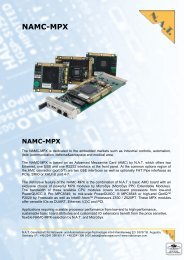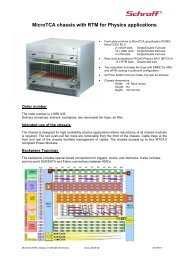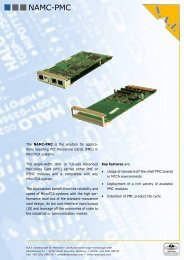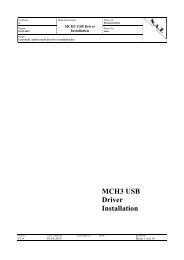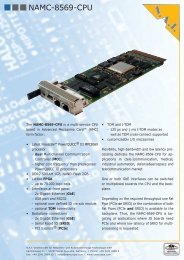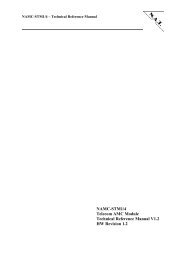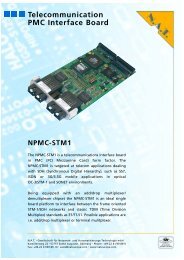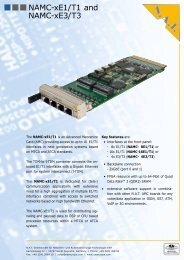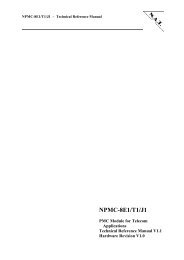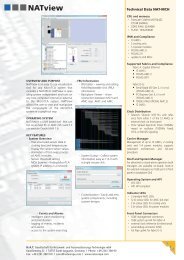PCI8280 Telecom PCI Module Technical Reference Manual ... - NAT
PCI8280 Telecom PCI Module Technical Reference Manual ... - NAT
PCI8280 Telecom PCI Module Technical Reference Manual ... - NAT
Create successful ePaper yourself
Turn your PDF publications into a flip-book with our unique Google optimized e-Paper software.
3.3.2 FLASH<br />
<strong><strong>PCI</strong>8280</strong> – <strong>Technical</strong> <strong>Reference</strong> <strong>Manual</strong><br />
FLASH memory is connected to the upper 16 data bits D0 – 15 and to the latched address<br />
lines. The FLASH on the <strong><strong>PCI</strong>8280</strong> can be programmed either by the CPU (by appropriate<br />
software or through the BDM port) or by a <strong>PCI</strong> bus master. In the latter case the<br />
PowerQUICC II has to be prevented from booting from FLASH while it does not contain a<br />
defined boot program, in order not to enter unknown states. This can be achieved by setting a<br />
DIL switch (SW1), which disables the MPC8280 CPU core after the following Power-Up<br />
cycle. This feature is used for programming the FLASH memory on the <strong><strong>PCI</strong>8280</strong> via the <strong>PCI</strong><br />
bus. If swich no. 1 of SW1 is set to ‘ON’ the Hardware Configuration Words for the CPU are<br />
loaded from an onboard CPLD. Some basic register setup is performed using the ‘Autoload’<br />
function of the MPC8280. Once the FLASH has been programmed, SW1 / 1 has to be set to<br />
‘OFF’ again. If the FLASH contains valid boot code, it may be reprogrammed without having<br />
to use SW1. Programming software is available on request. Please refer to section 5.4 for<br />
details on DIL switch SW1, and to section 6.1 for details on the Hardware Configuration<br />
Words.<br />
3.3.3 I 2 C Devices<br />
There are two I 2 C devices on the <strong><strong>PCI</strong>8280</strong>, which are connected to the MPC8280 I 2 C bus; an<br />
EEPROM used for storage of board-specific information, and the EEPROM on the SODIMM<br />
SDRAM module, which contains vital data about the SDRAM module size and address<br />
organisation. This information is necessary, in order to be able to program the SDRAM<br />
controller functions appropriately. The EEPROM on the SODIMM typically defaults to a<br />
24C02 type, the EEPROM for storage of board-specific information defaults to a 24C08<br />
device. The address of the EEPROM on the SDRAM SODIMM module is 0x0, the address of<br />
the other EEPROM is 0x4.<br />
Version 1.2 © N.A.T. GmbH 16




